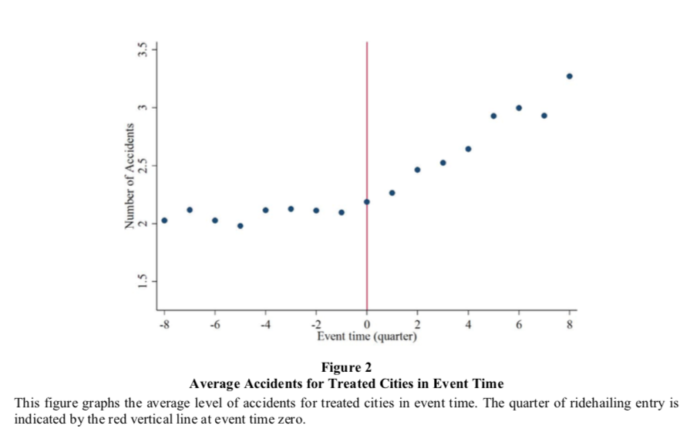[Update: Joe Cortright of City Observatory has published a critique of this study]
When Uber or Lyft starts serving a city, more people die in crashes. This is the horrifying finding of a new National Bureau of Economic Research (NBUR) paper by John M. Barrios, Yael Hochberg, and Hanyi Yi. From the abstract:
We examine the effect of the introduction of ridehailing in U.S. cities on fatal traffic accidents. The arrival of ridehailing is associated with an increase of approximately 3% in the number of fatalities and fatal accidents, for both vehicle occupants and pedestrians. The effects persist when controlling for proxies for smartphone adoption patterns. … These effects are higher in cities with prior higher use of public transportation and carpools, consistent with a substitution effect, and in larger cities. These effects persist over time. Back-of-the-envelope estimates of the annual cost in human lives range from $5.33B to $13.24B.
This chart says it all:
For each of the studied cities, the vertical red line represents the arrival of Uber or Lyft (whichever arrived first) and the dots are the traffic accident rates. The rate not only starts going up after Uber or Lyft arrive. It is still going up two years later. The paper goes into great detail, separating out possible related causes such as increasing cellphone use by motorists. The correlation is pretty strong. It is true of both the number of crashes and the number of people who die.
The authors find other evidence that isolates Uber and Lyft as the cause. In particular:
… the effect is concentrated in [ridehail]-eligible vehicles (relatively new, four-door vehicles) and is not present for accidents involving [ridehail]-ineligible vehicles (two-door vehicles). [p5]
One common selling point for Uber and Lyft is that they reduce drunk driving, but on balance, no:
We find that accidents and fatalities related to drunk driving do not decrease [after the arrival of Uber or Lyft]: if anything, we find evidence of a small increase … [p5]
I hope this all isn’t true, but if it is, it matters.
A few factors probably at work here.
Shifting trips from public transit to Uber or Lyft — which is definitely happening in major cities — means more than just increasing traffic. It means shifting people from a very safe mode of transport to one that is more dangerous, to the customer and to others on the street.
It’s not just that big transit vehicles are more crashworthy. Your bus driver has been selected and trained for safety, and is probably randomly tested for drug and alcohol use. Bus drivers also have training in anger management, so they know how to control the strong emotions that come up as things happen in traffic.
Uber and Lyft promise you none of these things. Drivers must have a clean driving record and criminal record, but beyond that the only promise of safety (for yourself and others) is that dangerous drivers get low ratings. What’s more, customers demand contrary things with their ratings. I give a low rating for driving over the speed limit in cities, because I value human life, but others might give a low rating for driving so slowly.
What I find, as a frequent user of both transit and Lyft, is that the safety of Lyft drivers is very diverse, and that the bad ones are very bad. Safety also varies dramatically by region. At home in Portland I rarely get a driver whose phone isn’t mounted on the dashboard, but when I use Lyft in Texas and Florida, most drivers have the phone in their laps, and drive along looking down.
Uber and Lyft are very useful, but we are learning more and more about their negative impacts: higher traffic, weakening support for essential public transit, and now, well, more people dying. Where does this end?
